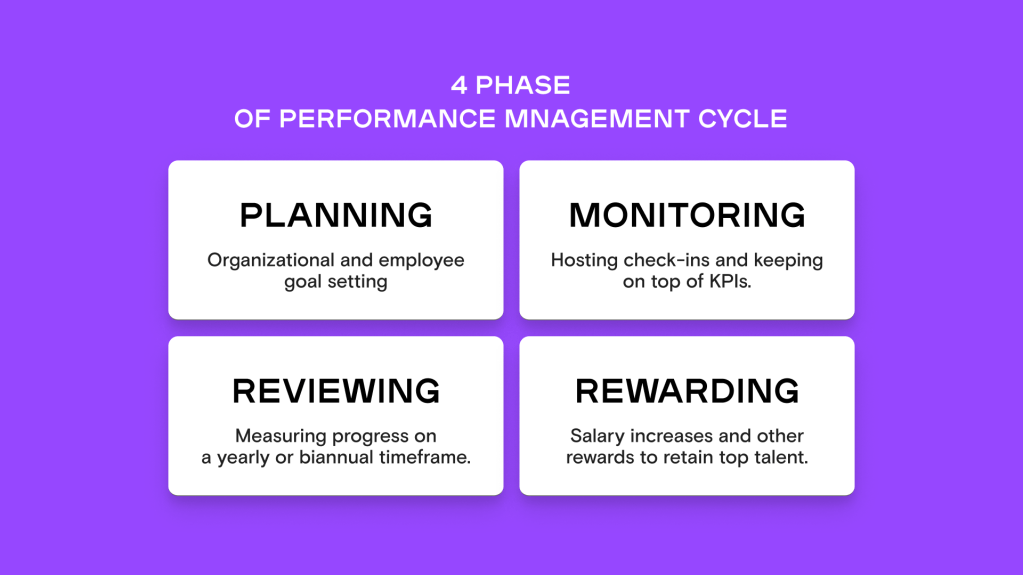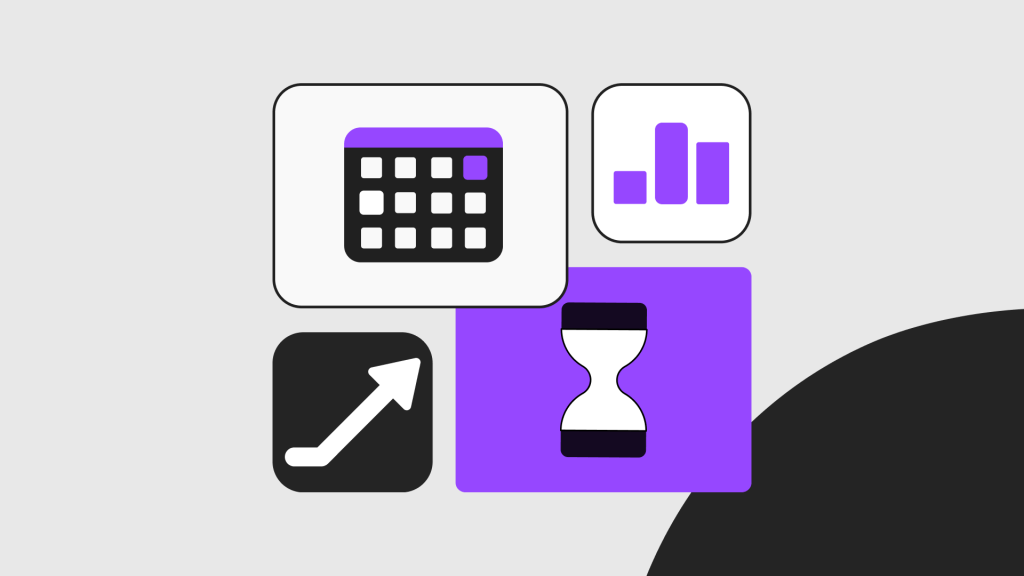Every organization should have a well-executed performance management cycle. It is part of a broader performance management cycle that can help an organization increase productivity through higher employee satisfaction and well-being. In this comprehensive guide to the performance management cycle, you’ll learn how to implement it and what are the benefits of using performance management software to establish a framework.
What Is Performance Management Cycle?
A Performance Management Cycle aims to continuously improve the process of planning and measuring performance. It operates similarly to performance management in that it is about aligning employee success with the organization’s success.
Why is Performance Management Cycle Important?
“Research indicates that workers have three prime needs: Interesting work, recognition for doing a good job, and being let in on things that are going on in the company.”
– Zig Ziglar –
An effective performance management cycle can help organizations meet strategic goals. A well-thought-out process will make revisiting organizational goals and responding to changing market conditions easier. You can create a more flexible framework for your operations.
Managing performance through a cyclical system will also provide more support for the team. Supported and appreciated employees will feel valued, more motivated, and satisfied. It can help with productivity and improve employee retention.
Key Components of a Performance Management System
You need the right tools to measure progress to establish a robust performance management cycle. Before implementing the framework, ensure you find an effective performance management system to guide you through.
A sound system should:
- Have strong involvement by the management team
- Set well-defined goals and objectives
- Maintain continuous development
- Implement open feedback systems
- Establish ongoing communication
These are the building blocks of performance management, and any good system should have them as the main principles.
The Typical Business Performance Management Cycle

The performance management cycle consists of four stages.
1. The Planning phase
The planning stage sets the groundwork for organizational success. Before you start talking with employees and organizing systems, you must identify objectives and goals for your project.
Your goal setting must consider both the overall strategy for your business as well as the personal objectives of your employees. Consider things like development goals, tasks, targets, behaviors and actions.
Once you know what you want the company and the employees to achieve, you can create a framework for the strategy. The best way is to use the SMART system where your goals are:
- Specific and outlined clearly with detailed information on what you want to achieve, how you’ll achieve it and why.
- Measurable so that you have a definite indicator to show if you acquired the goal or not.
- Achievable in a way that employees are realistically able to achieve them.
- Relevant to the point that the objective aligns with the worker’s job and overall organizational goals.
- Time-bound to provide a definite timeline for meeting the goals.
Creating a plan for the organization and the employees will help set the system on the right path of employee development.
2. The Monitoring phase
After the planning, you’ll enter the monitoring phase. Monitoring the progress monthly is essential, with some frameworks benefitting from a weekly or bi-weekly system.
You want to evaluate employee performance by breaking the goals into smaller subgoals. This not only advances the evaluation but also makes the goals more manageable. During the monitoring phase, gathering feedback on the framework is vital.
3. The Review phase
The review phase should occur at least once a year. During it, management should provide feedback to employees. Go over the goals, see which were met and what challenges and successes occurred over the year. You should also involve peer evaluations and self-assessment in the review phase.
4. The Rewarding phase
Finally, there is the rewarding stage of the performance management cycle. Motivation is quickly lost if employees are not rewarded for meeting their organizational goals.
There are several rewards in your arsenal. You can consider the following:
- Salary increases
- Flexible work arrangement
- Bonuses
- Promotions
- Special projects
Ensure the reward reflects the complexity of the goals. Getting a ‘participation sticker’ for achieving the biggest sale of the year might feel a bit shallow, after all!
Implementing Performance Management Cycle in Your Organization
How should your organization implement the cycle? There are five crucial steps for effective implementation. You should:
- Align performance management with organizational goals
Performance management should be decided, implemented and built upon with your organizational goals at the heart of it. You don’t want to create a system where employees work towards objectives that won’t help your organization grow. Professional development should be considered through organizational requirements, for example. What are the skills your staff should have to boost your organization further? Using the SMART strategy can help ensure your goal-setting benefits both the employee and the business.
- Involve all stakeholders in the process
The biggest mistake you can make is to implement performance management from the top. You want to ensure employees and other stakeholders are part of the process, not just living through it. Ask employee opinions, receive feedback and implement changes accordingly.
- Ensure continuous improvement and development
Indeed, it’s vital to view performance management as a continuous process. No framework is perfect from the start – if perfection is even possible! You should always keep feedback at the core and use it to improve the system.
- Establish open and continuous feedback mechanisms
There are significant differences in how you collect and use feedback. You don’t want to force feedback, and you certainly don’t want it to be something employees fear giving. This requires a lot of trust-building. You must ensure employees have the option to provide anonymous feedback and have channels to talk about issues at any stage.
Furthermore, you want feedback you and the management give to be positive and supportive. You can’t give constructive feedback without providing tools to improve. Always pair your feedback with mechanisms and support structures that help manifest the desired changes.
- Maintain ongoing communication
Above all, when implementing performance management, you need to keep talking. Communication throughout the performance management cycle ensures you’re aware of what’s happening – the good and the bad.
Measuring Performance Management Success

You’re not just measuring how well your employees perform with the performance management cycle. You should also check how well that performance management framework is doing. When measuring performance management success, you should:
- Focus on key performance indicators – These include things like employee retention and productivity.
- Monitor employee engagement and satisfaction – Check and analyze engagement levels and stay on top of employee satisfaction.
- Understand business growth and success – You should measure growth and understand what success looks like to your organization.
It’s crucial to remember that success isn’t just about figures that keep growing. You need to think about it more in terms of operational goals and business values. For example, you might be more concerned about having satisfied, motivated and healthy employees rather than hitting an operational target growth of 10% every year! Define what success looks like to your and your employees and move on from there.
Read More : The ROI of Performance Management: Measuring What Matters
Trends in Performance Management for 2023
Tools and different strategies are an essential part of performance management. The field is changing thanks to technological developments with things such as artificial intelligence and machine learning.
When you’re designing a performance management cycle in 2023, you want to focus on:
- Technology-driven performance management systems
- Focus on employee well-being and mental health
- Emphasis on continuous learning and development
These are the key elements a good guide to the performance management cycle will tell you to employ when searching for the right system.
Benefits of Using a Performance Management System
The benefits of the performance management cycle are best unleashed with a robust system. Performance management software can help you obtain operational and employee goals, enhancing relationships and productivity.
Using a performance management system can:
- Improve employee performance – The software can make it easier to manage many of the above elements, from implementation to measuring effectiveness. It can ensure your system is not disruptive but supports your workers in their daily tasks. If performance management is frictionless, the overall performance will remain better.
- Enhance employee engagement and satisfaction – A sound system can boost engagement. Your staff can communicate with management and stay on top of changes to the system or work in general. Positive and easy engagement will increase overall satisfaction.
- Align individual and organizational goals better – These systems, with their feedback and coaching tools, can help align personal and corporate goals.
- Streamline communication and feedback processes – An effective system comes with feedback tools that make it easier to collect and analyze performance reviews and employee feedback.
The right tools can make it easy to ensure the effectiveness of your framework and help employees achieve their performance goals.
Performance Monitoring in UAE Businesses
Performance monitoring in the UAE is still largely done through traditional methods like Excel spreadsheets. The unfortunate reality is that only around 26% of SMEs in Dubai follow well-defined practices for employee performance management. This isn’t good for business and could partially explain the low retention rates in the region.
While businesses could say that a lack of localized tools was an issue in the past, this isn’t the case anymore. Performance management tools, like Bayzat, are becoming more commonplace and can offer plenty of benefits to UAE businesses.
These tools can help with goal creation and monitoring. You can customize KPIs with goals and generate feedback without forgetting transparency and openness. Companies can unleash the benefits of performance monitoring tools, supporting a more innovative and inclusive workplace.
Conclusion

A successful performance management system can help businesses flourish. With it, you can yield significant returns with a positive ROI. The guide to the performance management cycle has shown that to receive these benefits, you must implement the systems well. You need to align your organizational goals with those of employee performance and measure the right metrics. Then, you will see the real impact of your framework and see your efforts yield positive results.
FAQ on Performance Management Cycle
Here are some of the most common questions on the performance management cycle:
What is the performance management cycle?
A performance management cycle is a process of enhancing individual and organizational performance. It involves planning, measuring, and enhancing employee performance, achieving operational goals in the meantime.
What are the five stages of the performance management cycle?
The five standard components of the performance management cycle are: planning, monitoring, developing, rating, and rewarding. This help achieves a natural and effective framework to support your employees.








Get Social